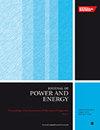叶片扩散器水冷却对离心压缩机内部流场影响的数值研究
IF 1.1
4区 工程技术
Q3 ENGINEERING, MECHANICAL
Proceedings of the Institution of Mechanical Engineers, Part A: Journal of Power and Energy
Pub Date : 2023-09-22
DOI:10.1177/09576509231200293
引用次数: 0
摘要
高速离心式压缩机由于其高压上升,气体温度会非常高,不利于压缩机的气动性能。为了解决这一问题,提出了水冷式叶片扩散器技术。压气机外壳采用一体化水冷却通道,通过叶片中心附近的孔将冷却水引入叶片。将该技术应用于一台180 mm涡轮增压器压气机,在叶尖速度为452 m/s时,进行了共轭传热和流固耦合的数值研究,研究了冷却对压气机性能和扩压叶片机械应力的影响。结果表明:冷却对压气机效率有提高作用,且随着压气机质量流量的减小,效率提高幅度增大;在适度的压力比为3.3左右时,使用30°C的进水温度可实现1.09个百分点的最大改进。研究发现,冷却可以显著降低扩散器通道固体壁面附近的空气温度,从而使压缩机出口的空气温度更加均匀。在空气质量为1.68 kg/s,进口温度为70℃和30℃时,扩散器出口温度分别降低了1.33℃和2.21℃。此外,扩散叶片的热应力随冷却而降低。本文章由计算机程序翻译,如有差异,请以英文原文为准。
A numerical investigation of the effect of vaned diffuser water cooling on the internal flow field of a centrifugal compressor
Due to their high pressure rises, the gas temperature of high-speed centrifugal compressors can be very high to the detriment of compressor aerodynamic performance. A water-cooled vaned diffuser technique is proposed to alleviate this problem. Compressor housing integrated water-cooling passages are employed to introduce cooling water to the vanes through holes near the vane centre. The technique was applied to a 180 mm turbocharger compressor running at the tip speed of 452 m/s, and numerical studies with conjugate heat transfer and fluid-structure thermal interaction were carried out to find the effects of the cooling to compressor performance and the mechanical stress of diffuser vanes. The results show that compressor efficiency is improved by the cooling, and the improvement increases as compressor mass flow reduces. At modest pressure ratios around 3.3, the maximum improvement of 1.09 percentage points is achieved using 30°C inlet water temperature. The cooling is found to significantly reduce the air temperature near diffuser passage solid walls, thus lead to more uniform air temperatures at compressor exit. The reduction of 1.33°C and 2.21°C in the diffuser outlet temperature have been found at 1.68 kg/s air mass flow with 70°C and 30°C water inlet temperature respectively. Moreover, the thermal stress in diffuser vanes is shown to be lower with the cooling.
求助全文
通过发布文献求助,成功后即可免费获取论文全文。
去求助
来源期刊

CiteScore
3.30
自引率
5.90%
发文量
114
审稿时长
5.4 months
期刊介绍:
The Journal of Power and Energy, Part A of the Proceedings of the Institution of Mechanical Engineers, is dedicated to publishing peer-reviewed papers of high scientific quality on all aspects of the technology of energy conversion systems.
 求助内容:
求助内容: 应助结果提醒方式:
应助结果提醒方式:


